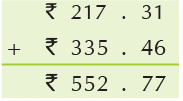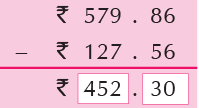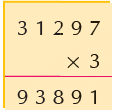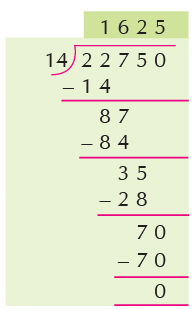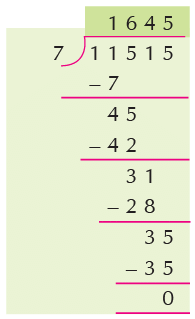Money Class 4 Notes Maths
What is Money?
- Money is what we use to buy things we need or want.
- It can come in different forms like coins, paper bills, or even digital numbers in a bank account.
- Think of it as a tool that helps us trade and get things without having to barter, which means trading goods directly.

- The money used in a particular country is called its currency.
- Example: In India, the currency is Rupees and paise.
Types of Money in Indian Currency
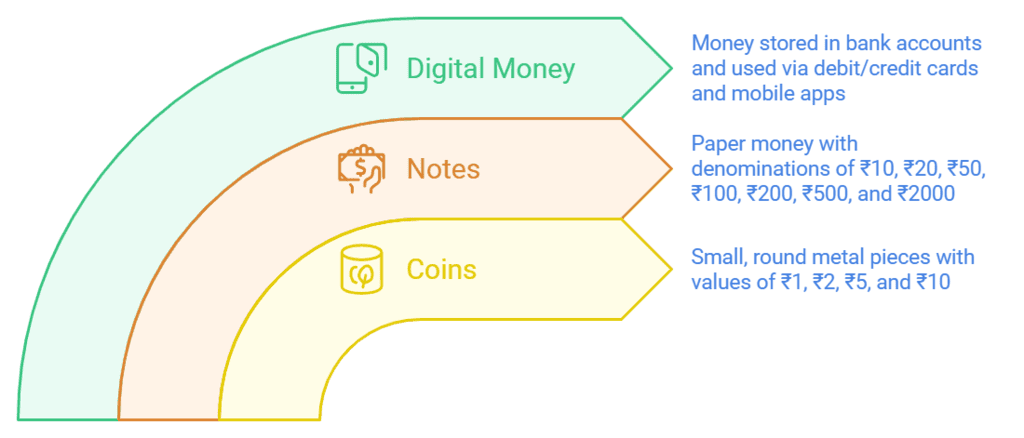 Types of Money in Indian Currency
Types of Money in Indian Currency
Coins:
- Small, round pieces of metal.
- Common values include ₹1, ₹2, ₹5, and ₹10.
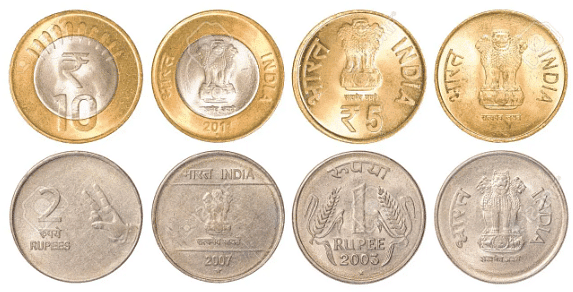 Coins in India
Coins in India
Notes:
- Paper money with different values.
- Common denominations include ₹10, ₹20, ₹50, ₹100, ₹200, ₹500, and ₹2000.
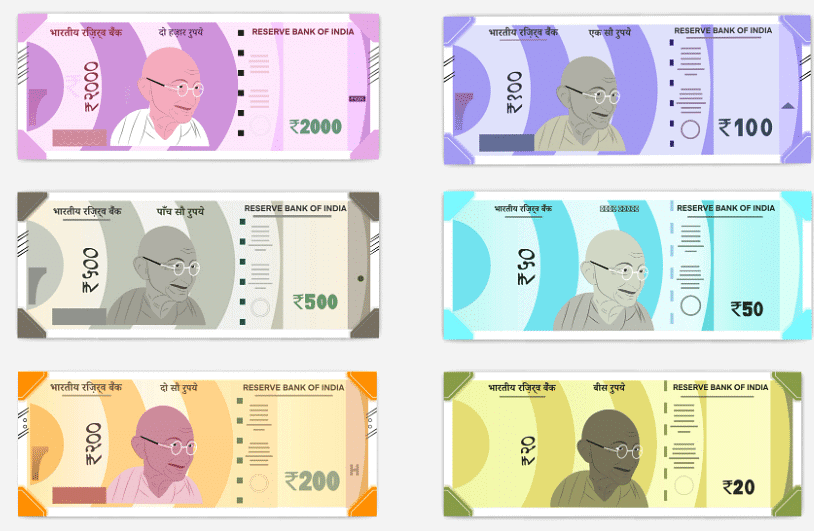 Note currency in India
Note currency in India
Digital Money:
- Money is stored in bank accounts, used with debit/credit cards, and mobile payment apps like Paytm and Google Pay.

- Money is stored in bank accounts, used with debit/credit cards, and mobile payment apps like Paytm and Google Pay.
Different countries use different currencies. Indian currency is known as rupees.
Indian Currency: Rupees and Paise
In India, the currency consists of two units: rupees and paise.
Rupees (₹):
- The main unit of currency.
- Written as ₹.
- Examples: ₹10, ₹50, ₹100.
Paise (p):
- Smaller unit of currency.
- Written as p.
- 100 paise = ₹1.
- Examples: 50p, 75p.
When money exceeds ₹1, it is expressed in rupees. For instance, ₹2.75 means 2 rupees and 75 paise.
Money can be written in words as well as in figures as follows:

Conversion of Rupees into Paise and Paise into Rupees
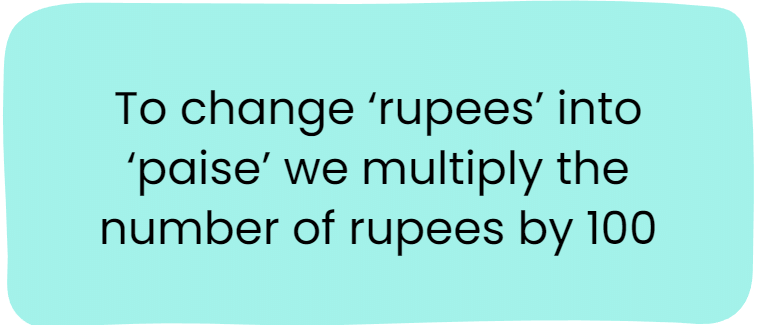
Example:
₹ 1 = 100 paise, Then
₹ 2 = 2 × 100 paise = 200 paise
₹ 3 = 3 × 100 paise = 300 paise,
₹ 4 = 4 × 100 paise = 400 paise
Below are some of the rules for the conversion of rupees into paise and vice versa.
Rule 1:
To change an amount in ‘rupees’ and ‘paise’ into paise we multiply the number of rupees by 100 and add it to the number of paise.
Example 1: Convert 35 rupees 25 paise into paise.
Sol: 35 rupees 25 paise = (35 × 100) paise + 25 paise
= 3500 paise + 25 paise
= 3525 paise
Rule 2:
To convert an amount given in rupees into paise, we remove the symbol of ₹ and the point and write paise.
Example 2: Convert the following amounts into paise.
(a) ₹ 41.25
(b) ₹ 106.50
(c) ₹ 0.25
Sol: (a) ₹ 41.25 = 4125 paise
(b) ₹ 106.50 = 10650 paise
(c) ₹ 0.25 = 25 paise
Rule 3:
To convert an amount given in paise into rupees, we put a point after two digits from the right of the given number showing paise. The number on the left of the point gives the number of rupees and that on the right gives paise.
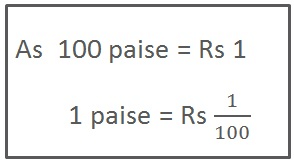 Conversion of rupees into paise and vice versa
Conversion of rupees into paise and vice versa
Example 3: Convert the following into rupees.
(a) 4535 p
(b) 9p
(c) 505 p
Sol: (a) 4535 p = ₹ 45.35
(b) 9p = ₹ 0.09
(c) 505 p = ₹ 5.05
Addition of Money
Some practical situations involve the addition of money. To find the total amount we write one amount under the other such that the point is exactly under the point and add ordinary numbers.
Example 4: Add ₹ 217.31 and ₹ 335.46.
Sol: Steps to add money
Step 1: Write the amounts.
Write ₹217.31 and ₹335.46 one below the other. Make sure the decimal points are in a straight line.Step 2: Start adding from the right (paise).
Add the hundredths (1 + 6 = 7).
Add the tenths (3 + 4 = 7).
Now, the paise is 77 paise.Step 3: Add the rupees.
Add the units (7 + 5 = 12). Write 2 and carry over 1.
Add the tens (1 + 3 = 4), and don’t forget the carry-over. So, 4 + 1 = 5.
Add the hundreds (2 + 3 = 5).Step 4: Write the final total.
The final answer is ₹552.77 or 552 rupees and 77 paise.
Subtraction of Money
Some practical situations involve the subtraction of money. To find the difference we write one amount under the other such that the point is exactly under the point and subtract as ordinary numbers.
Example 5: Subtract ₹127.56 from ₹579.86.
Thus, ₹579.86 – ₹127.56 = ₹452.30.
Multiplication of Money by a Number
Some practical situations involve the multiplication of a sum of money expressed by a number using a point. To find the product we multiply in the usual way and put the point two places from the right.
Example 6: Find ₹312.97 × 3.
Sol: We have
31297 × 3 = 93891
₹312.97 × 3 = ₹938.91
Thus ₹312.97 × 3 = ₹938.91.
Division of Money by a Number
Divide the amount given by the given whole number, taking the amount as an ordinary number. Put a decimal point after 2 digits from the right in the quotient.
Example 7: Divide ₹22750 by 14.
Thus, the quotient is ₹1625.
Example 8: Divide ₹115.15 by 7
First divide 11515 by 7
₹11515 ÷ 7 = 1645
Hence, ₹115.15 ÷ 7 = ₹16.45
Estimating Money
At times, we do not need to know the exact amount of money, but we need to get an idea of the cost. To find it, we round off the amount to the nearest rupee. This is called the estimation of money.
Example 9: Round off the following to the nearest rupee:
(a) ₹523.96
(b) ₹684.35
Sol: (a) ₹523.96 = ₹524 (Rounding 96 p to the nearest hundred, we get 100 p or ₹1.)
₹523 + ₹1 = ₹524(b) ₹684.35 = ₹684 (Rounding 35 p to the nearest hundred, we get 0 p. This can be taken as ₹ 0.)
₹684 + ₹0 = ₹684
Estimating Sum and Difference
Sometimes, it's helpful to round off amounts to the nearest rupee to make calculations easier. Here's how you do it:
Steps to Round Off Amounts
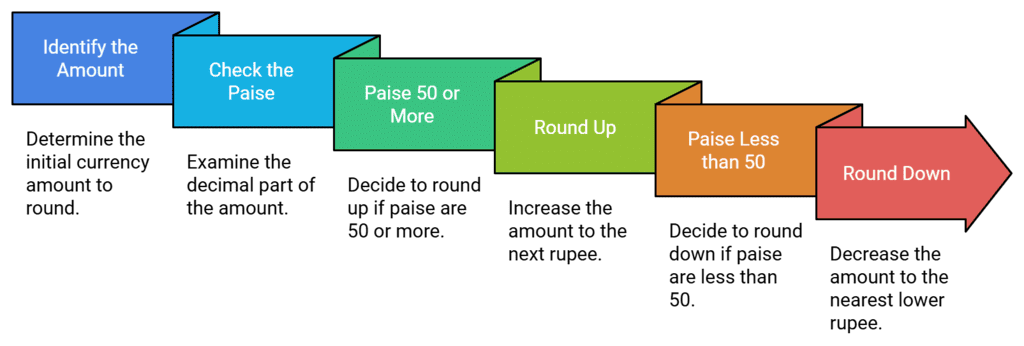
Example:
Amount: ₹112.86
- The decimal part is .86 (which is more than 50).
- Round up to the next rupee: ₹112.86 becomes ₹113.
Amount: ₹39.63
- The decimal part is .63 (which is more than 50).
- Round up to the next rupee: ₹39.63 becomes ₹40.
Adding Rounded Amounts
After rounding off, you can add the amounts easily.
Example:
- Original amounts: ₹112.86 and ₹39.63.
- Rounded amounts: ₹113 and ₹40.
- Add the rounded amounts: ₹113 + ₹40 = ₹153.
|
33 videos|168 docs|30 tests
|
FAQs on Money Class 4 Notes Maths
| 1. What is money and why is it important? |  |
| 2. How do you convert Rupees into Paise and vice versa? |  |
| 3. How do you add and subtract money amounts? |  |
| 4. How can you multiply and divide money amounts by a number? |  |
| 5. What is the best way to estimate money amounts? |  |


